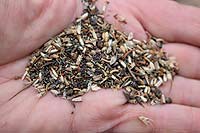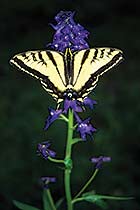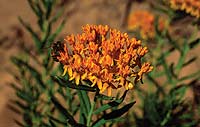 A handful of wildflower seeds sprouts a child-like wonder at the diversity and tenacity of these tiny structures. For many desert annuals and perennials, these seeds represent the future, the survival of a species which seems like such an overwhelming responsibility for such a tiny thing.
A handful of wildflower seeds sprouts a child-like wonder at the diversity and tenacity of these tiny structures. For many desert annuals and perennials, these seeds represent the future, the survival of a species which seems like such an overwhelming responsibility for such a tiny thing.
Small as they are, the seeds of desert plants are tough, notorious for their patience, and unique in their dispersal strategies.
For starters, some seeds have a tough outer coating that protects the inner embryo. Some seeds need a physical roughening to wear down this protective coat prior to germination, others need to pass through the digestive system of some creature.
Seed dispersal strategies are a stark contrast between species. Think of the weedy dandelion, with its silky plumes attached to a lightweight seed. The plumes act like a parachute when the wind shakes the seeds loose from the plant, sending them airborne away from the parent plant to colonize new ground. Many dandelion relatives in the Aster or Sunflower family employ this means of dispersal which not only gets the seeds aloft but also blows them along the ground’s surface before the seeds lodge into the soil or against other vegetation. Milkweeds seeds also are topped with fine hairs to aid in catching the wind.
In early summer, the cottonwood trees release millions of fluffy seeds in a snowstorm-like flurry to get the seeds away and into the water where a river or creek where the seeds will eventually be deposited on the edges of moist sandy beaches. As the seeds germinate, the roots follow the level of soil moisture as it lowers from the peak of the runoff.
Other seeds may have tiny oil appendages attached to a seed tip that entice ants to haul the seeds away back to their nest. The appendage, called an elaiosome, provides nutrients for ants while the ground nest provides an ideal spot to protect the seed as it awaits germination. It’s fascinating to watch a parade of ants returning to their nests with various bits of vegetation or seeds.
One thing that is common amongst desert seeds are the growth-inhibiting compounds that lock the seed in a protective vault. Once these chemicals are broken down by sufficient soil moisture or some other process, the seed begins to germinate.
Sand verbena, a beautiful flower which resembles a snowball when in bloom, needs winter moisture or early spring rains to induce the seeds to germinate. During years of adequate rainfall or snowmelt, this may result in a prolific bloom, literally carpeting the desert with wildflowers. These “super blooms” are reason enough to call in sick and scamper off to the desert to enjoy these infrequent events. Consider that a square meter of desert soil may hold thousands of seeds awaiting these right conditions for the next generation. 
Prior to seed set, one has to give props to the pollinators, the bees and flies, butterflies and hummingbirds, beetles and wasps that provide pollen-transferring services for desert wildflowers, enabling them to pass along genetic material and fertilize the flowers. The pollinators often receive nectar or pollen rewards for their services. One such pollinator is the yucca moth which pollinates yucca flowers and whose activities may be observed with a nocturnal visit to catch the action.
Throw in color flowers to this mix of pollinator and seed diversity and it’s no wonder that these wildflowers entice desert enthusiasts to this landscape.